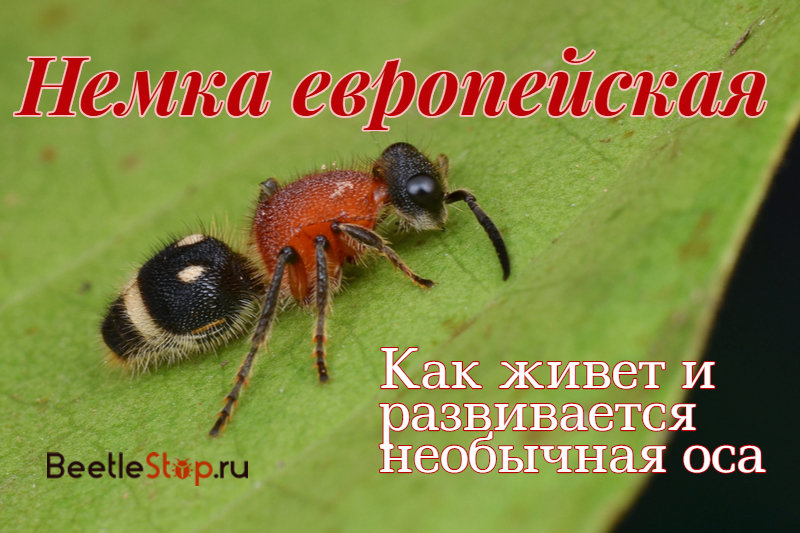European German - velvet ant with a sharp sting
Among solitary wasps, there are insects that look and behave unusually. European German is a species characterized by a velvety cover of the body, the absence of wings in the female and a parasitic way of life. Insects do not build their own nests, but attack aliens to lay their eggs there. Aggressive Germans are endowed with toxic poison, helping them cope with other insects. When attacking a person, the bite site hurts for several hours.

Morphological description of the species
European German (Mutilla europeae) is one of 4 thousand species of the German wasp family. Insects prefer a warm climate, arid steppes and semi-deserts. The pitiful hymenoptera are of interest due to the striking differences in the appearance of representatives of different sexes.
Sexual dimorphism
Female. The body length of the insect is 10-15 mm. The back of the head is expanded, the forehead is convex. There is a red-brown spot on the crown. Eyes of medium size, elliptical in shape, eyes reduced. Antennae 12-segmented. The main body color is black, the chest is rusty red. The back is continuous, not divided by grooves. On the abdomen, consisting of 6 sternites, a pattern of light spots or bandages. The limbs are well developed, on the lower legs of the middle and hind legs there are sharp spurs. The upper part of the head and chest are covered with short black hairs. Abdomen and limbs in fair hairs. Wings are missing. Females have a sharp powerful sting to protect themselves from enemies.
Information. Flightless females, quickly running through soil and trees, resemble ants in appearance. For a thick and soft hairline they are called velvet ants.
Males. Males are larger than females, their body length is 11-17 mm. On the sides of the black head are deep, undeveloped eyes. In addition to the main complex eyes, males have developed simple eyes. Antennae 13-segmented. Chest often with a brownish-red spot and well-defined seams. The body, legs and antennae are black. Front wings with dimming. Abdomen consists of 8 visible sternites. On the 1st, 2nd and 3rd tergite light stripes. The body is covered with dark hairs.
Interesting fact. On 2-3, remove the abdomen of males, there is a stridulatory organ, with the help of which they make sounds attracting females. Females are also able to make sounds at the moment of danger.
Distribution area
German wasps live in the Eastern Palaearctic zone. Insects are found in many countries of Europe (Italy, Spain, France), the Middle East and North Africa. In Russia they live in the south of the European part.
Lifestyle
German os years are observed from May to the end of August. Adult insects feed on bodyagi, forest angelica. This is additional nutrition, after leaving the pupa, the supply of nutrients is enough for 2 weeks. Males prefer sweet plant secretions. Females are less common in flowers, but also not averse to tasting nectar. Wasps are not active all daylight; they are mobile 4-5 hours a day.
The ability of German women to inflict painful injections with a sting served as a pretext for the various names “cow slayer”, “mule killer”. In fact, insect venom is not enough to harm large animals. Red spots in the color of wasps warn others about its danger.The number of insects is influenced by environmental pollution and negative changes in habitats. The view of a European German is listed in the Red Book of the Smolensk region. The number of insects in the region is still at a sufficient level, but there is a downward trend.
Propagation Features
The European German woman does not build her own nests, but is a parasitoid of Lepidoptera, Hymenoptera, insects. Most often, wasps lay eggs on bumblebee larvae. Sometimes Germans attack Apis mellifera honeybees. Females run on the ground in search of the host's nests, for the location she uses sensitive antennae. They penetrate into the dwellings where the larvae appeared and lay their eggs on them. After 3-4 days, the German offspring appears. In larvae of the first age, the mandibles are strong enough to gnaw the integument of the host (usually in the chest area) and begin feeding.
The owner is eaten completely, the size of the future wasp depends on its size. Germans fed on bees less insects that developed on bumblebees. Parasitoids hibernate at the pupal stage. They create their own cocoon inside the host. In spring, imagoes gnaw outward. Males appear first, they make frequent flights in search of females for mating. During this period, they feed on nectar. For females, the most characteristic is the exhaustion of the bodies of dead insects. Insects lead a secretive lifestyle, so they are difficult to observe.

